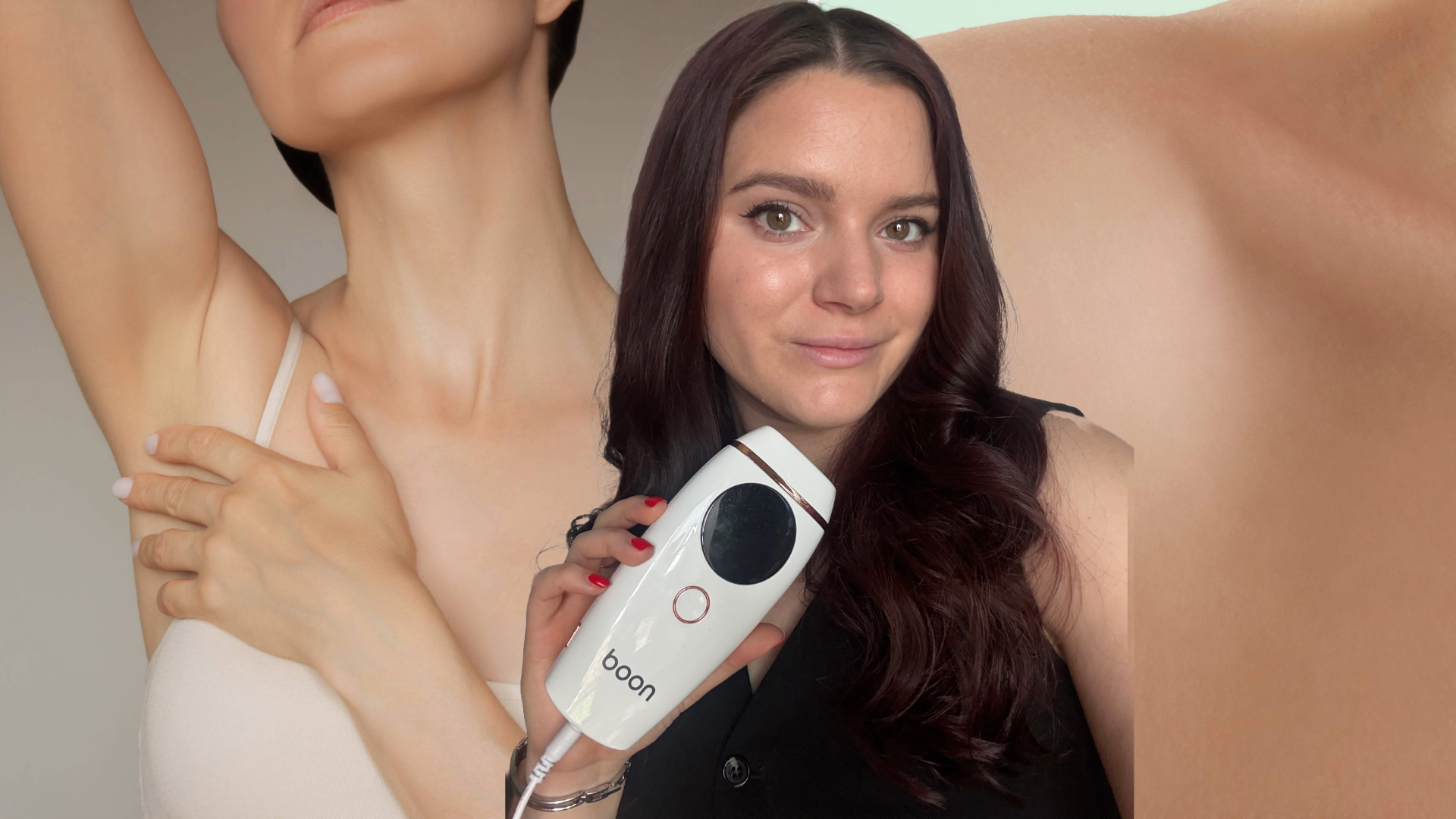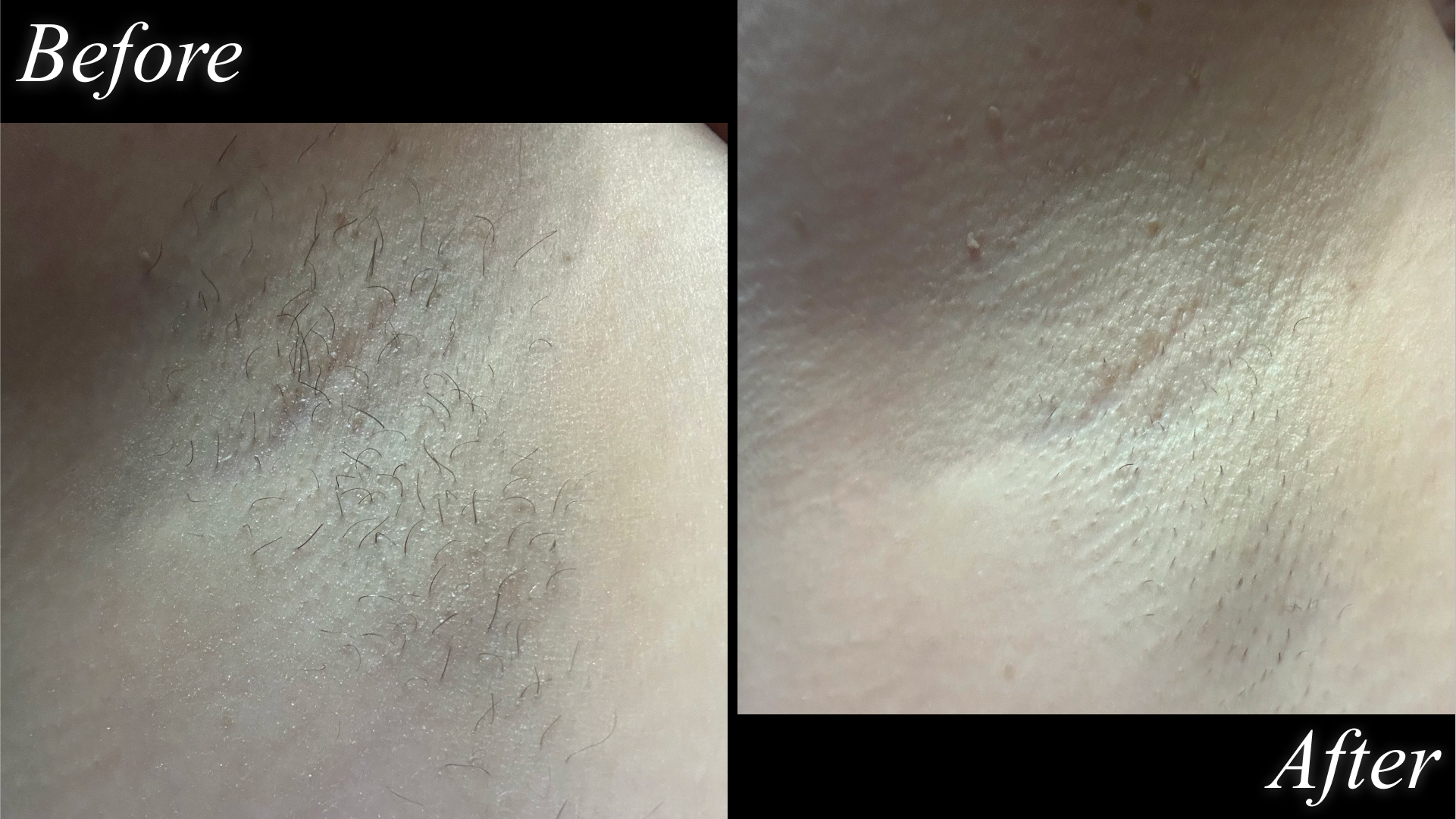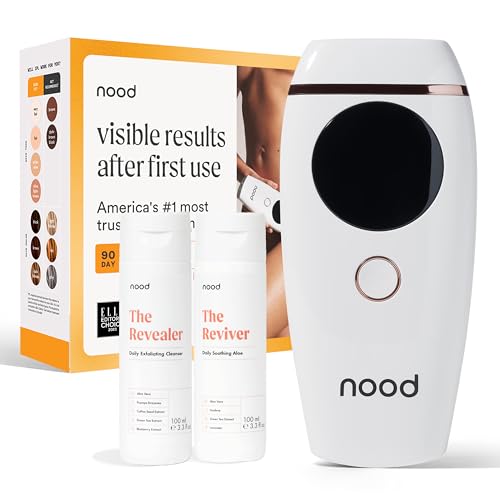The Nood 2.0 Flasher Made Me Believe in At-Home Laser Hair Removal Devices
After testing the $199 device myself, my shaving routine will never be the same.


If I'm being honest, hair removal is the most annoying part of my beauty routine. Sure, no one has to shave or wax if they don't want to—body hair is natural, after all. However, I prefer silky smooth skin from nearly my eyebrows down. From applying loads of shaving cream, carefully gliding my razor, and dealing with ingrown hairs, shaving is a painstaking process. So much so, when I heard about at-home laser hair removal devices—particularly the Nood Flasher 2.0—I was all too ready to give up.
I came across Nood’s laser hair device while doomscrolling through my beauty-filled For You Page. A TikToker was praising the device for its ability to give her baby-seal smooth skin for weeks on end. As a shopping editor, I couldn’t help but feel skeptical, especially when the brand itself claims “visible results after just one use.” So I did what any editor would do and got my hands on the device myself.
After eight weeks of testing the Nood Flasher 2.0, I have lots of thoughts. It’s not nearly as scary as it initially sounded, and I was pleasantly surprised by my results. Ahead, I’m answering every burning question you may have about the Nood Flasher 2.0, including how it works and how long it takes to see results. Then, I’m laying down my brutally honest review.
How It Works
The Nood Flasher 2.0 uses IPL technology, which stands for intense pulsed light. It sends broad-spectrum light into the deep layers of skin to be absorbed by the melanin in hair follicles. The light is then converted into heat, which destroys the hair follicles over time. IPL differs from professional laser hair removal as it covers a larger surface area, whereas an in-office laser is more precise and uses a single monochromatic light source. As such, you can typically expect quicker results with an IPL device than a single-laser tool.
To my relief, the Nood Flasher 2.0 couldn't be easier to use. The device has a total of two buttons: the side button to power the device on and change between the seven intensity levels, and the middle button to emit a flash and change modes. You can choose between two modes: Manual or Continuous. In Manual mode, you press the middle button to emit a flash, and it’s best used for smaller areas like the face and bikini line. Continuous mode, on the other hand, automatically emits a flash as you move the device over your skin and is great for large areas like the legs and arms to speed up treatment time.
Before you get to flashing, prep is crucial! Be sure to shave the treatment area ahead of time, as any long hairs will block the light from hitting the follicle under the skin, plus exposed hair may also cause burns or irritation. Once the area is shaved, plug in the device, power it on, and choose your preferred mode. Test your skin’s sensitivity first by starting at the lowest intensity level before working your way up. Make sure you’re holding the device flush against dry, clean skin at a 90-degree angle, then either press the flash button in Manual mode or wait for the device to flash automatically in Continuous mode. Flash over the entire treatment area, then repeat twice more, for a total of three complete passes. Most treatment areas will take less than 10 minutes to complete, but larger areas like the legs, arms, and back may take longer.
Keep in mind that the Nood Flasher 2.0 isn’t suitable for everyone. You shouldn’t use this device if you have very dark skin (specifically, Type 5 or 6 on the Fitzpatrick scale) as those skin types could absorb too much light energy and potentially cause injuries. This device also isn’t safe to use if you have light blonde, red, or gray hair—IPL devices require contrast between the melanin in your hair and skin, so these hair colors would be too fair for the light to penetrate.
Get exclusive access to fashion and beauty trends, hot-off-the-press celebrity news, and more.
How Long Until You See Results
For optimal results, Nood recommends completing two full treatments per area a week, for eight weeks. After two months of use, you can dial back treatments to once a month for a year to maintain your results.
With this treatment plan in mind, Nood says you can see visible results (a reduction of hair growth and count) within the first week of use. However, you’ll really start to notice a difference at the two-to-three mark. That’s when you can expect 50 percent hair reduction. After eight weeks, you’ll notice the best results at anywhere from 80 to 90 percent hair reduction.
My Review of the Nood 2.0 Flasher
While I jumped at the chance to test Nood’s laser hair device, I became nervous once I had the box in my hand. I’m a notorious baby when it comes to pain, so zapping my skin again and again didn’t exactly sound pleasant. Alas, I’ll try anything once in the pursuit of beauty.
To kick off testing, I treated my armpits, which have hair that grows in fast and coarse. So much so that it’s part of my shower routine to do a couple of quick passes with my razor. I started on the level three intensity and, because I wanted to do quick treatments, used the Continuous mode.
It turns out that I had nothing to be nervous about—the treatments were by no means painful and, if anything, felt like a quick burst of heat on my skin. The only jarring part of the process was how bright the light was, but I got used to it quickly. I worked my way up to level five, but I did experience some sharp zaps with levels six and seven. The inside crease of my armpits was a tad more sensitive than the rest of the area, but again, it didn’t hurt.

Brooke Knappenberger's results before and after testing the Nood Flasher 2.0 for eight weeks.
It took me a while to get adjusted to the process in the initial treatment, but by the second or third go of it, I was competing both armpits in about five minutes or less. I’m a rule follower to a T, so I did two treatments a week for the full eight weeks. It was around the third week that I started to notice a change. Suddenly, I only needed to shave my armpits every three days or so for completely hairless skin, and the hair that did grow in was a lot less coarse and dark. Then by week eight, I could cut down on shaving to nearly two weeks.
Don't get me wrong, the Nood Flasher 2.0 is by no means a miracle-working device. It takes consistency to see results, and it doesn't offer permanent hair removal (at least in my case). To be honest, I've slacked off on keeping up with my maintenance treatments; however, I can still go about five days without shaving my pits. Considering I used to shave every day, this is a major improvement in my book. The fact that this device is $199 is another win, too—for reference, an in-office laser hair removal session will run you anywhere from $150 to $500, and you could need six to eight sessions depending on the treatment area and your features. If you're looking to reduce shaving time, are willing to put in the work, and are on a budget, I couldn't recommend this device enough, but if you're hoping for permanent results, I'd say go the professional route.
Why Trust Marie Claire
For more than 30 years, Marie Claire has been an internationally recognized destination for news, fashion and beauty trends, investigative packages, and more. When it comes to the products Marie Claire recommends, we take your faith in us seriously. Every product that we feature comes personally recommended by a Marie Claire writer or editor, or by an expert we’ve spoken to firsthand.

Brooke Knappenberger is the Associate Commerce Editor at Marie Claire, where she specializes in crafting shopping stories—from sales content to buying guides that span every vertical on the site. She also oversees holiday coverage with an emphasis on gifting guides as well as Power Pick, our monthly column on the items that power the lives of MC’s editors. She also tackled shopping content as Marie Claire's Editorial Fellow prior to her role as Associate Commerce Editor.
She has over three years of experience writing on fashion, beauty, and entertainment and her work has appeared on Looper, NickiSwift, The Sun US, and Vox Magazine of Columbia, Missouri. Brooke obtained her Bachelor's Degree in Journalism from the University of Missouri’s School of Journalism with an emphasis on Magazine Editing and has a minor in Textile and Apparel Management.
